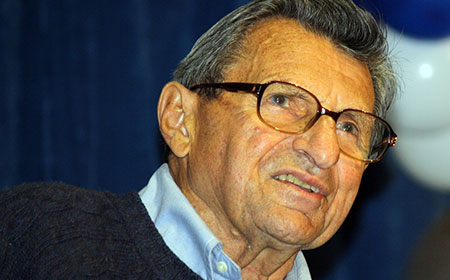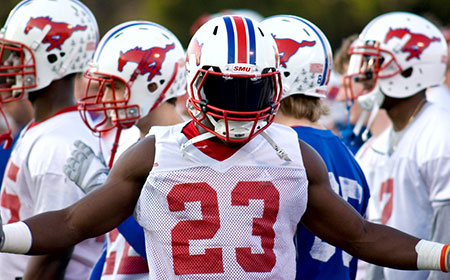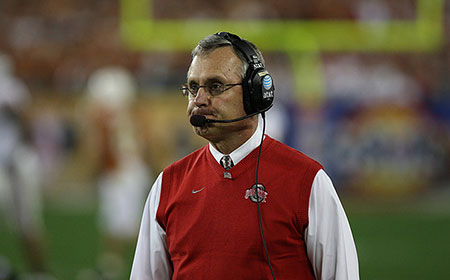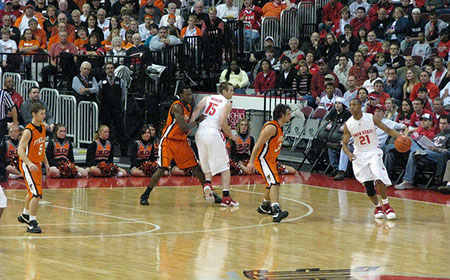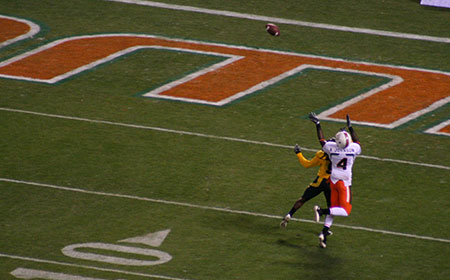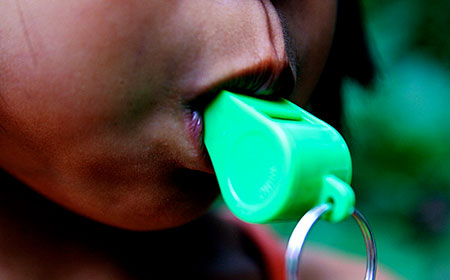| ||
|
Friday, August 10, 2012
When chemo is the right choice
Wednesday, August 8, 2012
Non-stick unfortunately is not Non-Toxic
Teflon Update: It's Worse than We Thought
Two years ago, I wrote to let you know the fumes from Teflon, given off when a pan is heated, were killing people's pet birds (that was Issue #49, if you want the details). As far as I'm concerned, if it causes a parakeet to keel over, I don't want it in my life.
Now there's more news about this bird-killing toxin that's undoubtedly in your home — and in your bloodstream, too. It's in the bloodstream of almost every single one of us.
PFOA is the ingredient used in Teflon that causes the problems. I'm afraid new findings have surfaced to support the health hazards of this modern-day "convenience."
Continued below...
Now there's more news about this bird-killing toxin that's undoubtedly in your home — and in your bloodstream, too. It's in the bloodstream of almost every single one of us.
PFOA is the ingredient used in Teflon that causes the problems. I'm afraid new findings have surfaced to support the health hazards of this modern-day "convenience."
Continued below...
You've got to watch this
I recently came across what I believe is the most promising cancer advancement of the past 30 years.
A neurochemist developed it over the course of 20 years. Already several major studies (on over 10,000 patients combined) have verified its accuracy. The FDA has even approved it. But, strangely, this cancer discovery has been kept almost completely quiet. (The reason why made me furious -- I bet you'll feel the same way.) I just finished creating this special video alert… It's got everything you need to know about this medical development. You've got to watch it now... |
Chemicals of "convenience" are literally everywhere
Let's recap before I hit you with the latest unsettling revelations. Teflon itself was an "accidental" invention by a chemist in 1938. The fellow was trying to make a refrigerant and instead came up with the non-reactive, low-friction substance known as polytetrafluoroethylene (PTFE) — what we know as Teflon.Since then, PTFE has been employed as a coating on pots, pans, wiper blades, curling irons, stain-resistant carpets, and even microwave popcorn bags — just to name a few chemical-laced modern-day conveniences.
The chemical PFOA is a key ingredient in Teflon (PTFE). PFOA, or perfluororctanoic acid (and also known as C8), is a carcinogen, is toxic to animals, and persists in the environment indefinitely.
At least 99% of the general population in the U.S. have traces of PFOA in their bloodstream (up from 95% a few years ago). Folks who work in chemical plants or live near chemical plants probably have much higher levels than everybody else.
We knew this was coming
We've known for a while that Teflon was a likely health offender. The fact that Teflon fumes kill birds was our first clue. For instance,
- When a Teflon-lined oven was used to bake biscuits at 325 degrees Fahrenheit, an owner reported the death of his parrots.
- When four stovetop burners lined with Teflon drip pans were preheated for a meal, 14 birds died within15 minutes.
- And when Teflon-coated heat lamp bulbs were installed in chicken pens, half of the chicken population passed away within a few days.
Our next clue was the health concerns voiced by workers at the DuPont Washington Works plant in the Mid-Ohio Valley. DuPont paid out a $300 million settlement in response to a class action lawsuit from plant workers and those who live near the plant in Ohio and West Virginia, all alleging DuPont contaminated their drinking water with PFOA.
If a corporation settles a lawsuit one always suspects they were in the wrong, but you can't be sure. There wasn't a proven link between cancer and PFOA ... until now.
If a corporation settles a lawsuit one always suspects they were in the wrong, but you can't be sure. There wasn't a proven link between cancer and PFOA ... until now.
No such thing as an "acceptable" toxic level
Because of the allegations in that West Virginia and Ohio region, a panel of public health scientists have been monitoring the long-term health of the community through epidemiologic and other data. The panel was approved by DuPont as part of the class action lawsuit over PFOA.
The evidence they've found is chilling. The low-but-constant levels of PFOA consumed by residents in their drinking water have upped the rates of kidney and testicular cancer. For kidney cancer, risk is up by a shocking 170 percent. Thyroid cancer may also be affected by PFOA.
That same panel of independent scientists found another hair-raising health link last year. Their findings showed a link between PFOA and preeclampsia (a condition during pregnancy that can have catastrophic consequences for both the mother and the fetus). And they recently found a link between PFOA and both thyroid disease and ulcerative colitis.
Olga V. Naidenko, Ph.D., a senior scientist at the Environmental Working Group, said "Widespread pollution by PFOA should be a wake-up call that our chemical regulation system is severely broken." She added, "It is particularly urgent for the Environmental Protection Agency to develop a legal limit for drinking water pollution by PFOA, which is currently unregulated and never should have come to market."
I agree that this is a wake-up call. But I think the only acceptable "legal limit" is zero.
The evidence they've found is chilling. The low-but-constant levels of PFOA consumed by residents in their drinking water have upped the rates of kidney and testicular cancer. For kidney cancer, risk is up by a shocking 170 percent. Thyroid cancer may also be affected by PFOA.
That same panel of independent scientists found another hair-raising health link last year. Their findings showed a link between PFOA and preeclampsia (a condition during pregnancy that can have catastrophic consequences for both the mother and the fetus). And they recently found a link between PFOA and both thyroid disease and ulcerative colitis.
Olga V. Naidenko, Ph.D., a senior scientist at the Environmental Working Group, said "Widespread pollution by PFOA should be a wake-up call that our chemical regulation system is severely broken." She added, "It is particularly urgent for the Environmental Protection Agency to develop a legal limit for drinking water pollution by PFOA, which is currently unregulated and never should have come to market."
I agree that this is a wake-up call. But I think the only acceptable "legal limit" is zero.
A global phase-out is our best bet for future health safety
Right now, there's a voluntary pact between eight major U.S. companies, including DuPont, to "virtually" eliminate the use of PFOA by 2015. The pact was put together by the Environmental Protection Agency. The goal is to drastically reduce the shocking extent to which PFOA shows up everywhere (pizza boxes are another offender).
According to DuPont's spokeswoman, Janet E. Smith, "DuPont has commercialized new alternatives that are made with short chain chemistry that cannot break down into PFOA."
On the flip side, Leann Brown, press secretary for the Environmental Working Group (EWG), points out "Had DuPont done sufficient human safety testing before bringing this product into commerce, they would have found this chemical was unfit for commercial production and use."
The American Cancer Society points out there is very little data about the ability of PFOA to cause cancer, but also states the major U.S. health agencies have not formally evaluated PFOA and its connection to cancer. And keep in mind, DuPont isn't the only offender that's been using this chemical, though it's the only current American maker of PFOA. Loads of companies overseas continue to produce and use it.
There may not be any formal study results, but all signs point in that direction. If you ask me, it's not worth waiting around for a bureaucratic process to tell us what we already know. Although sadly, this doesn't help the fact that it's probably already in your bloodstream. PFOA has even been found in the blood of marine life and Arctic polar bears.
All you can really do at this point is make an effort to avoid the stuff as much as possible. This means staying away from Teflon-coated cookware, or anything that's heat-resistant or non-stick. Clothes are also possible offenders, so avoid buying anything labeled wrinkle-free, stain-resistant, or waterproof.
If you have a hankering for popcorn, here's good news: You can pop ordinary kernels in your microwave in a simple, chemical-free, brown paper bag. In the meantime, I'll be watching for updates from DuPont as it phases out the chemical. And I'll be hoping someday for a global phase-out.
According to DuPont's spokeswoman, Janet E. Smith, "DuPont has commercialized new alternatives that are made with short chain chemistry that cannot break down into PFOA."
On the flip side, Leann Brown, press secretary for the Environmental Working Group (EWG), points out "Had DuPont done sufficient human safety testing before bringing this product into commerce, they would have found this chemical was unfit for commercial production and use."
The American Cancer Society points out there is very little data about the ability of PFOA to cause cancer, but also states the major U.S. health agencies have not formally evaluated PFOA and its connection to cancer. And keep in mind, DuPont isn't the only offender that's been using this chemical, though it's the only current American maker of PFOA. Loads of companies overseas continue to produce and use it.
There may not be any formal study results, but all signs point in that direction. If you ask me, it's not worth waiting around for a bureaucratic process to tell us what we already know. Although sadly, this doesn't help the fact that it's probably already in your bloodstream. PFOA has even been found in the blood of marine life and Arctic polar bears.
All you can really do at this point is make an effort to avoid the stuff as much as possible. This means staying away from Teflon-coated cookware, or anything that's heat-resistant or non-stick. Clothes are also possible offenders, so avoid buying anything labeled wrinkle-free, stain-resistant, or waterproof.
If you have a hankering for popcorn, here's good news: You can pop ordinary kernels in your microwave in a simple, chemical-free, brown paper bag. In the meantime, I'll be watching for updates from DuPont as it phases out the chemical. And I'll be hoping someday for a global phase-out.
Tuesday, August 7, 2012
The 10 Most Impressive Mental Athletes Alive Today
The 10 Most Impressive Mental Athletes Alive Today
August 6, 2012
While most of us are proud if we can remember all the state capitals or the bones in the human body, some serious mental athletes out there go above and beyond when it comes to pushing their brainpower. Able to remember dozens of random words and calculate numbers out to thousands of digits, these mental athletes put the average good memory and mental prowess to shame. Yet while these skills are impressive, the top mental athletes claim that anyone can do what they do with the right training and dedication. Read on to learn more about the impressive feats of some of the world's leading mental athletes and how you can emulate their methods for superior memory and mental abilities.
Wang Feng:
Chinese memory champ Wang Feng is only 22, but his young age hasn't slowed his meteoric rise to the top of world memory rankings. Feng won the 2010 World Memory Championships with a record-breaking score of 9,486 points, moving him to the top of the world rankings, a spot he continues to hold. He is able to memorize 300 digits of spoken numbers, 500 digits of written numbers, and can read off the order of a deck of cards in just 24.22 seconds. Feng uses a combination of rhymes and pictorial associations to remember such large amounts of data. He associates numbers with a rhyming word (in Chinese) and the image that goes along with it. Feng has said that this system comes naturally to him, as it is often used in his native Chinese language as a memory device. While the system may be most conducive to Chinese, a similar method could be used in any language to help individuals remember numbers, names, or other information.Simon Reinhard:
Simon Reinhard holds two of the fastest times ever recorded for memorizing a 52-card pack of playing cards, both just over 21 seconds. He also holds top-10 honors in a wide range of other memory tasks from remembering names and faces to reciting random words. This German national began competing in memory competitions in 2005 and has never looked back. In order to attain his impressive records, Reinhard uses a technique called the method of Loci, creating memory places and images to help him recall vast amounts of information. It's a mnemonic device that dates back to Roman times, perhaps still popular because of its obvious effectiveness. Numerous books and studies have been done on the process, and it's likely that with proper training, most people will be able to master the basics in about an hour.Johannes Mallow:
According to world rankings, Johannes Mallow has the third best memory of anyone in the world. Mallow took top honors at the Cambridge Memory Championship in 2011 and the Swedish Open Memory Championship, as well as placing second in the World Memory Championship in 2009 and 2010. He holds the top records for 30-minute numbers, 5-minute historical figures and dates, as well as placing in the top five in a large number of other memory trials. Along with memory champ Simon Reinhard, Mallow also uses the method of Loci to help him remember. For example, every three-digit combination of numbers gets a unique image in his mind. Similarities in their methods may be because both Mallow and Reinhard are closely associated with the German group Memory XL, which helps anyone, even those with average memories, boost their skills.Ben Pridmore:
Ben Pridmore is one of the best-known mental athletes in the world today. He has been competing since 2000 and his long career has netted him a number of top honors in competitions around the world, including three first place World Memory Championship wins and five back-to-back UK Open Memory Championships. He boasts the No. 1 score in six different memory trials and held the world record for card memorization until his record was broken in 2010 by Simon Reinhard. Pridmore isn't just a champ for memorization, however, as this accountant has also taken top honors in mental calculation. Pridmore's methods are fairly similar to that of other top memory competitors. He begins by creating a mental story, creating a sequence of images that he remembers, each representing groups of numbers or playing cards. Pridmore often uses his old grammar school as the setting for these memories, though others wishing to copy his methods could use any familiar place.Gunther Karsten:
As of 2011, Gunther Karsten held the fifth best score at the World Memory Championships. Since 1998, Karsten has taken home first and second place honors at dozens of memory championships, including winning first place in the World Memory Championships in 2007. He excels at memorizing binary, recalling 3,570 digits with only 30 minutes to prepare. This German champ is a chemist and biotechnologist when he's not competing and also teaches classes on mental learning and memory training for the general public. Karsten is another proponent of mnemonic methods of memorization, showcasing his skills on television and even in a movie about his life. Along with other German memory champs, he is a member of Memory XL, which we have previously mentioned, and uses many of the methods they teach to attain his own titles.Astrid Plessl:
Astrid Plessl is the most highly decorated female memory champ in the world today. She ranks first in the world for memorizing poetry and sixth for memorizing cards, holding a number of other top positions as well for her memory abilities and capturing a number of memory championships, as well as two second place wins in the World Memory Championship. Plessl is currently retired from the memory competition circuit, but still comes out for certain festivals and events. While Plessl does use mnemonic devices for memorizing things like cards and numbers, the same methods don't work as well when memorizing poems, what she holds the world record for. She has never revealed her exact method, but some believe that it's a combination of natural memory and using mental imagery to help tell the story of the poem. No matter how she does it, the benefits of memorizing poetry can be numerous, and it should perhaps be one of the first avenues of building a better memory that individuals pursue.Dominic O'Brien:
Dominic O'Brien is an eight-time world memory champion, perhaps best known for his Guinness record-breaking performance in 2002 when he memorized the order of 2,808 playing cards with only eight errors. O'Brien became inspired to take on memory-related challenges in 1987 when he saw a BBC television program on record-breaking abilities and has since turned his interest into a thriving career. O'Brien is more than happy to share his methods with others, developing the Mnemonic Dominic System, which has been the basis for several books he has written on boosting memory power. Similar to many mental champs on this list, O'Brien uses a mnemonic method, the guidelines for which he shares through his company, Peak Performance Training.Nelson Dellis:
Two-time winner of the U.S. Memory Championship winner Nelson Dellis didn't get the title by luck. Dellis is able to memorize the full order of a deck of shuffled cards in 63 seconds and more than 300 numbers in under five minutes, breaking several records at the 2011 championships. Yet Dellis says these abilities aren't the result of a photographic memory or any kind of inborn abilities. In fact, he believes that anyone can do what he does, provided they train and practice just as if they were competing in any other physical event. Inspired by the memory loss he saw his grandmother, who suffered from Alzheimer's, endure, Dellis began researching memory improvement methods. He uses a number of mnemonic methods to help him remember everything from cards, to numbers, to names, and believes that anyone with average memory abilities can do the same.Michael Glantz:
Nicknamed "The Tank" for his power lifting prowess, this young memory champ (he's just graduated from high school) is both a formidable physical and mental force to be reckoned with. Despite an emergency appendectomy in 2011 just weeks before the USA Memory Championships, Glantz was on his game, capturing top honors in poetry memorization, finishing third overall, which is commendable against older, more experienced competitors. He would also help lead his high school to top honors in the team competition, the fourth consecutive win for the school. In this year's competition he would come out on top in both poetry and names and faces and is proving to be a name to watch in memory championships. How does he do it? Glantz uses many of the same mnemonic methods as other memory champs, associating words, numbers, or cards with images in his mind.Priyashi Somani:
When it comes to mental calculations, there is perhaps no better brain in the world today than that of Priyashi Somani. What is even more impressive is that Somani was just 11 years old when she captured the Mental Calculation World Cup. She was the youngest participant in the cup's history, and the only one to ever have 100% accuracy in addition, multiplication, and square roots, and set a new world record for calculating square roots. As for being able to copy her methods, that might prove a bit difficult. Unlike other mental champs on this list, her skills seem to be natural, and she only practiced for a few months before heading to and capturing the win at the MCWC. While average people may never be able to match her impressive abilities, a few mental calculations here and there can't hurt to boost your mental power.
Wednesday, August 1, 2012
THE 10 MOST EMBARRASSING MOMENTS IN NCAA HISTORY
by staff writers
July 31, 2012
We all love to see the embarrassing “Not Top 10″ plays where a player, say, picks up a football and runs it into the wrong endzone. It’s lighthearted fun that no doubt leaves the player feeling a bit sheepish for a little while. But sometimes, sports programs find themselves embroiled in much deeper, much more disgraceful scenarios of their own design. These highly public embarrassments can ruin lives, cost schools thousands or millions of dollars, and leave the entire country with a bad taste in its mouth. These 10 cases are hopefully the most embarrassing moments in NCAA history any of us will have to witness.
Jerry Sandusky brings down Joe Paterno:
What a horrible irony that Penn State’s alma mater includes the words, “May no act of ours bring shame.” For more than 15 years, coaching assistant Jerry Sandusky disgraced the school by sexually abusing boys placed in his care. The resulting embarrassment enveloped once-beloved head coach Joe Paterno, the Penn State football program, the NCAA, and every fan of college football in America. “JoePa” did not live to see his statue removed from its place near Beaver Stadium and forklifted into storage, or his record vacated of more than 100 wins, knocking him from atop the list of winningest college football coaches ever. For the NCAA, having such a man in the record books was clearly too humiliating.Reggie Bush stripped of the Heisman:
Whether college athletes should be paid for their services is a debate worth having. Nevertheless, as the rule stands (and as it stood in the early 2000s), accepting nearly $290,000 in cash and gifts is $290,000 more than players are allowed to accept. USC star running back Reggie Bush was certainly not the first to take people’s offers of limo rides and free housing, but he was the first to go on to win the Heisman Trophy. In a huge black eye for USC and the Heisman Trust, Bush opted to relinquish the award before it was snatched out of his soiled hands, the first time the award has been returned.SMU gets the death penalty:
In the wake of Penn State’s devastating NCAA punishment, many are reminded of another name in the annals of college sports embarrassments: Southern Methodist University. Although Penn State will retain a crippled football program, SMU’s entire 1987 and 1988 seasons were canceled when it was discovered players had been paid thousands of dollars out of a slush fund with the full knowledge of people like former Texas governor and chairman of SMU’s board of governors Bill Clements and AD Bob Hitch. Ironically, Penn State was among the schools who raided SMU’s football roster for players. As a result of the death penalty, SMU’s program took two decades to recover, Clements’ political career was killed, and the Southwest Conference had one of the final nails put in its coffin.CCNY point-shaving:
Players accepting money for playing their best is one thing; players taking money for making errors and helping bookies beat the spread is a whole other can of worms. In 1951, a cloud was cast over NCAA basketball when a point-shaving scandal involving seven schools and 32 players came to light. What began with the arrest of three of the stars of City College New York’s NIT-winning 1950 team for conspiring with gangsters to fix games soon spread to NYU, Long Island University, the University of Kentucky, and elsewhere. The scandal remains one of the worst black eyes in college basketball history.Jim Tressel and Tattoo-Gate:
 Jim “The Sweater Vest” Tressel was so ensconced as head football coach at Ohio State that when asked if Tressel was going to be fired, OSU president Gordon Gee responded, “No, are you kidding? I’m just hoping the coach doesn’t dismiss me.” Clearly Tressel’s 106-22 record with OSU had brought him significant power, power enough that, when informed his players were selling memorabilia to a known drug dealer in exchange for tattoos, he sat on the knowledge for eight months in 2011. Then he lied to investigators about how long he knew the truth. A red-faced OSU tried to keep Tressel’s chastening to a five-game suspension and $250,000 fine, but ultimately bowed to public pressure and asked for his resignation.
Jim “The Sweater Vest” Tressel was so ensconced as head football coach at Ohio State that when asked if Tressel was going to be fired, OSU president Gordon Gee responded, “No, are you kidding? I’m just hoping the coach doesn’t dismiss me.” Clearly Tressel’s 106-22 record with OSU had brought him significant power, power enough that, when informed his players were selling memorabilia to a known drug dealer in exchange for tattoos, he sat on the knowledge for eight months in 2011. Then he lied to investigators about how long he knew the truth. A red-faced OSU tried to keep Tressel’s chastening to a five-game suspension and $250,000 fine, but ultimately bowed to public pressure and asked for his resignation.Minnesota brawls with Ohio State:
The thought process while watching the clip of this embarrassing moment in college basketball history goes something like this: ‘OK, that was a pretty hard foul. Oh, nice, that player is going to help him up OH, NOT THE GROIN!’ Angered at an impending loss to their Big Ten rivals, Minnesota initiated a street fight by punching and kneeing Ohio State player Luke Witte and then stomping his head while he was on the floor. The crowd even booed him as he was helped off the court on his way to the hospital. The governor of Ohio called it a “public mugging.” Two Minnesota players were suspended for the season, and dunking before games — showboating that the NCAA believed attributed to the hostile environment — was banned.Miami brawls with FIU:
To call this Miami football’s all-time low is saying a lot, considering their history. But on the night of Oct. 14, 2006, the country watched in disgust as Hurricane players goaded Florida International’s Golden Panthers into a fight with taunting and showing off. FIU took the bait. A Golden Panther tackled a holder and punched him, and all hell broke loose. Miami players took their helmets off and used them as weapons. An injured FIU player swung a crutch at some Hurricanes. A ‘Cane body-slammed a Panther. Players were stomped and kicked in the head. State troopers had to help separate the teams. More than 30 players were later suspended. Even a TV commentator, former Hurricane Lamar Thomas, was fired for the embarrassing in-game comments, “You come into our house, you should get your behind kicked.”University of Minnesota academic fraud:
Minnesota basketball managed to go almost 30 years after the 1972 brawl before falling on their faces in front of the country all over again. On the morning of the team’s first-round game in the 1999 NCAA tournament, news broke of a former academic advisor claiming to have written 400 papers for Gopher basketball players over a period of five years, with head coach Clem Haskins’ total knowledge. Haskins later admitted paying the woman to do so and was subsequently fired and banned from coaching college basketball until 2007. Some supporters wished he would have fought harder to clear his name, but he correctly decided that would have only dragged the school’s name further through the mud than it had already traveled.Nevin Shapiro blows the whistle on Miami:
When Nevin Shapiro was imprisoned in 2010 for participating in a nearly $1 billion Ponzi scheme, more than a few people in the college sports world must have started to worry. Such worry is warranted. Eight players on the Miami Hurricanes football team have already been suspended for accepting gifts from this persona non grata, but according to Shapiro, dozens more players are involved. He says from 2002 to 2010 he hooked up at least 72 college players with money, prostitutes, yacht and limo rides, tackle bounties (which are currently roiling the NFL), jewelry, and travel. Shapiro is peeved at his predicament and has vowed he will take Miami football down with him.Rick Pitino is blackmailed:
 Three, six, and 15. These are the numbers of Rick Pitino’s most notable achievements: three schools led to the Final Four, six NCAA Tournament regional championships, and 15 seconds of sex with extortionist Karen Cunagin Sypher. In one of Louisville basketball’s most embarrassing moments, and certainly the most embarrassing moment of Pitino’s storied career, the coach had an extremely brief sexual encounter with the wife of his equipment manager in a restaurant booth in 2003. The woman then tried to milk Pitino for $10 million. Pitino called the cops on her but in so doing opened himself up to some humiliating courtroom interrogation and accusations of rape by Sypher. Ultimately he was vindicated, but not until adding another sad chapter to the college sports history books.
Three, six, and 15. These are the numbers of Rick Pitino’s most notable achievements: three schools led to the Final Four, six NCAA Tournament regional championships, and 15 seconds of sex with extortionist Karen Cunagin Sypher. In one of Louisville basketball’s most embarrassing moments, and certainly the most embarrassing moment of Pitino’s storied career, the coach had an extremely brief sexual encounter with the wife of his equipment manager in a restaurant booth in 2003. The woman then tried to milk Pitino for $10 million. Pitino called the cops on her but in so doing opened himself up to some humiliating courtroom interrogation and accusations of rape by Sypher. Ultimately he was vindicated, but not until adding another sad chapter to the college sports history books.
Subscribe to:
Comments (Atom)



 their backs totally on chemotherapy, surgery and radiation. Their doctor, their family, and everybody else insists they submit to the same mainstream treatments other patients get.
their backs totally on chemotherapy, surgery and radiation. Their doctor, their family, and everybody else insists they submit to the same mainstream treatments other patients get.

 cancer patients.
cancer patients. diagnosis confirmed her worst fears: Kathy had aggressive breast cancer.
diagnosis confirmed her worst fears: Kathy had aggressive breast cancer. her stress levels...cut back on her intense exercise program (she was overdoing it)...and brought more balance and harmony into her life.
her stress levels...cut back on her intense exercise program (she was overdoing it)...and brought more balance and harmony into her life. you...
you... Bonus Report today. It's YOURS FREE with every copy of CANCER PIONEERS.
Bonus Report today. It's YOURS FREE with every copy of CANCER PIONEERS.












